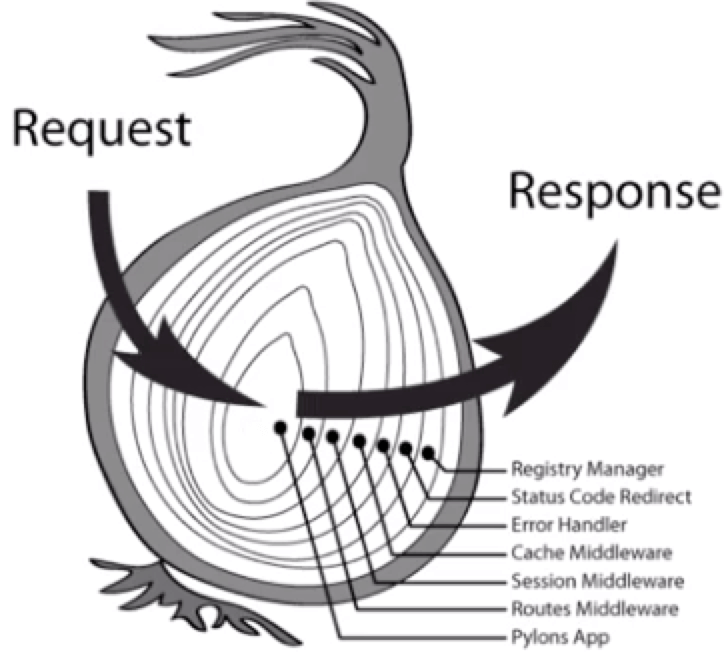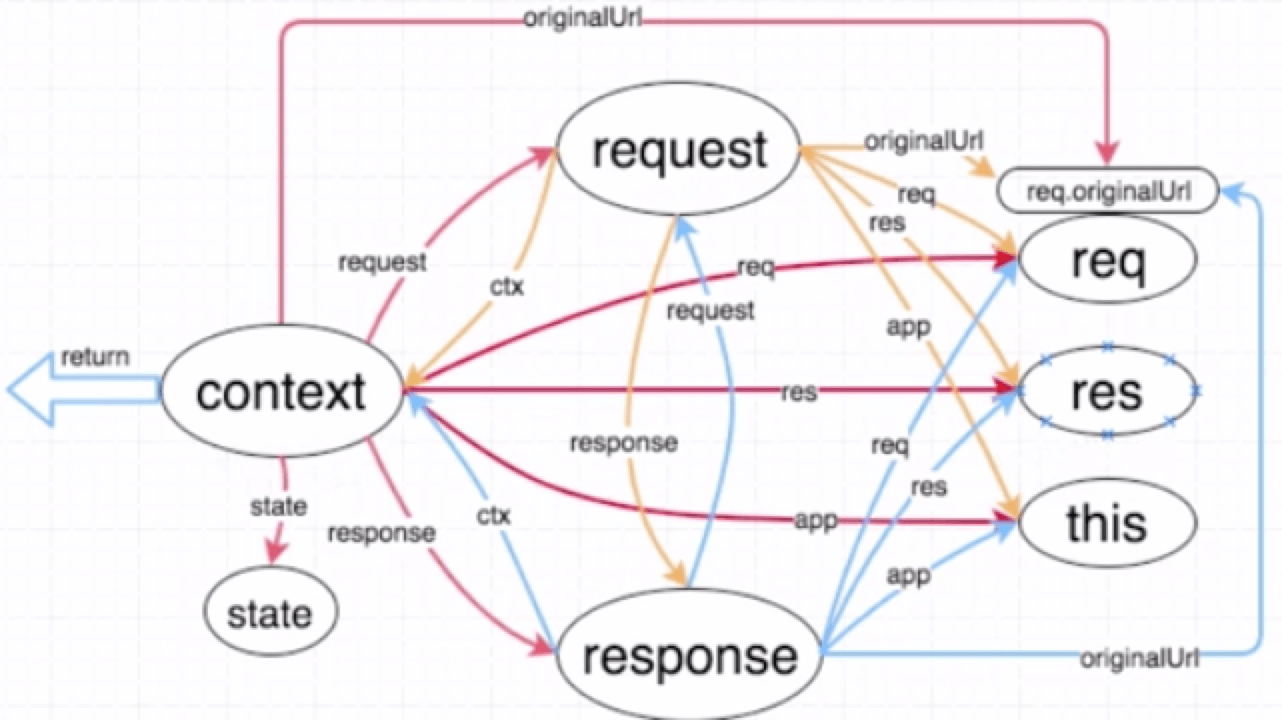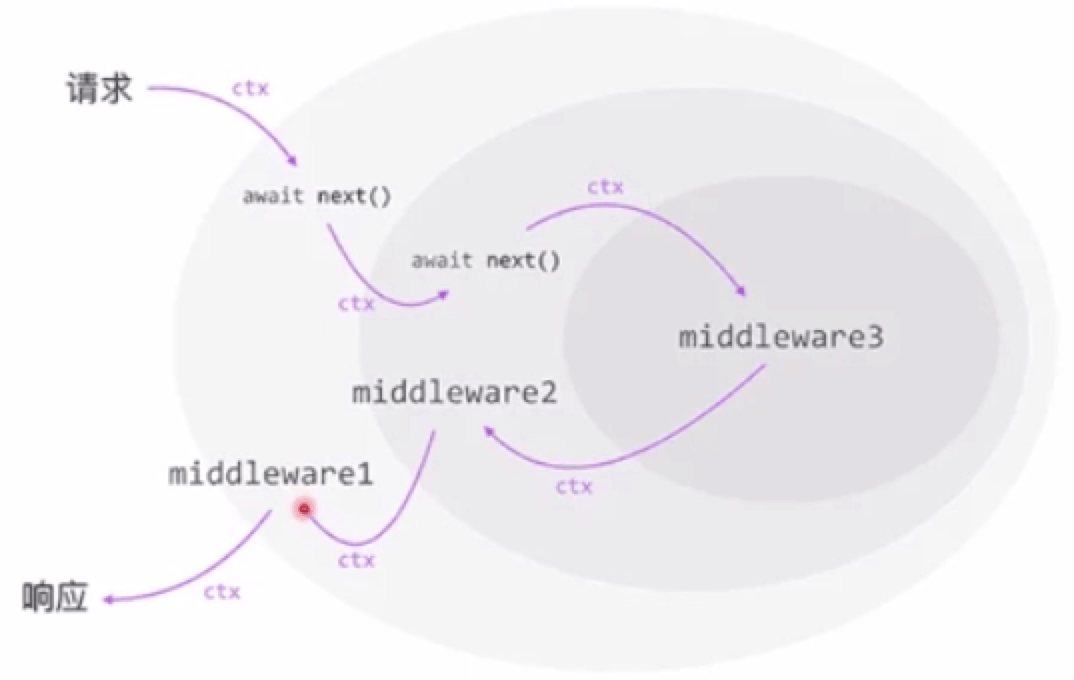# 2.1 Nodejs web框架及koa
# 2.1.1 Nodejs常见的框架
| 框架名称 | 特性 | 评价 |
|---|---|---|
| Express | 简单、实用、路由中间件等五脏俱全 | 最著名web框架 |
| Hapi&Restify | 面向API&微服务 | 移动互联网时代API作用被放大,故而独立分类,尤其是对于微服务开发更是利器 |
| ThinkJS | 面向新特性 | 借鉴ThinkPHP,并慢慢走出自己的一条路,长于新特性执行,新版V3.0是基于Koa2.0的作为内核的 |
| Koa | 专注于异步流程改进 | 下一代web框架 |
| Egg | 基于Koa,在开发上有极大的便利 | 企业级Web开发框架 |
# 2.1.2 Koa概览
- Express很简洁,Koa更简洁
- Koa应用程序是一个包含一组中间件函数的对象,它是按照类似堆栈的方式组织和执行的
- 内置优雅的底层中间件处理内容协商,缓存清理,代理支持和重定向等常见任务的方法,开箱即用
# 洋葱模型
请求一层层的进入,一层层的退出,也就是说先进的后出,后进的先出

从下面代码可以看出,完全是遵循洋葱模型从1-9执行过程,通过next把模块串联起来,koa的洋葱模型允许我们加入很多中间件的处理
const Koa=require('koa')
const app=new koa()
// x-response-time
app.use(async (ctx,next)=>{
const start= Date.now() //1
await next() // 2
const ms=Date.now()-start // 8
ctx.set('X-Response-Time',`${ms}ms`) // 9
})
// logger
app.use(async (ctx,next)=>{
const start= Date.now() //3
await next() //4
const ms=Date.now()-start //6
ctx.set(`${ctx.methods}${ctx.url}-${ms}`) //7
})
// reponse
app.use(async ctx=>{
ctx.body='Hello World' //5
})
app.listen(3000)
2
3
4
5
6
7
8
9
10
11
12
13
14
15
16
17
18
19
20
21
22
23
24
25
26
27
28
29
# Koa常见的中间件
- koa-static处理静态资源
- koa-router 处理路由
- koa-session 保存网络请求状态
- koa-bodyparser 处理请求体
- koa-compress 压缩响应数据
- koa-logger 输出服务日志
- koa-error 处理响应错误
# 2.1.3 使用Koa编写web Server
# REST 接口设计-路由
//接口要遵循http动词
GET /xhr/v2/templateList // 获取模版列表
GET /xhr/v2/templateDetail?id=xx // 模版单个模版详情
POST /xhr/v2/templateCreate // 创建模版
PUT /xhr/v2/templateChange/1 // 修改模版,
DELETE /xhr/v2/templateDelate/1 // 删除模版
2
3
4
5
6
我们使用社区提供的优秀脚手架去构建项目,github上搜索awesome-koa可以找到koa相关社区资源,例如:https://github.com/fineen/awesome-koa,在文档里找到这koa-rest-api-boilerplate这个脚手架;一个小技巧,以awesome为前缀去找框架相关资源。
# --depth表示克隆深度,1表示克隆最进一次的commit
git clone --depth=1 https://github.com/posquit0/koa-rest-api-boilerplate.git
cd koa-rest-api-boilerplate
rm -rf .git && git init
2
3
4
看一个框架,首先看package.json文件,看脚本运行了哪些命令,然后看入口文件。
├── app
├── config
│ ├── cors.js # 配置cors,跨域相关配置
│ ├── index.js # 项目环境相关配置
│ └── logger.js # 配置错误相关
├── connections
│ └── apm.js # 实时监控应用性能和当前工作负载
├── constants # 常量
├── controllers # 业务层
│ └── template.js
├── middlewares # 中间件
├── model # 数据模型
│ └── template.js
├── routes # 路由
│ └── template.js # template模块的路由
├── index.js
└── utils
├── http.js # 请求封装
└── reponse.js # 响应数据封装
└─ package.json
2
3
4
5
6
7
8
9
10
11
12
13
14
15
16
17
18
19
20
# 1. 编写数据模型
const mongoose = require('mongoose');
const templateSchema = mongoose.Schema({
name: String,
template: String,
data: String
});
module.exports = mongoose.model('template', templateSchema);
2
3
4
5
6
7
# 2. 编写router
const Router = require('koa-router');
const templateController = require('../controllers/template');
const router = new Router();
router.prefix('/xhr/v2');
router.get('/templateList', templateController.templateList);
router.post('/templateCreate', templateController.templateCreate);
router.get('/templateDetail', templateController.templateDetail);
router.put('/templateChange/:id', templateController.templateChange);
router.del('/templateDelate/:id', templateController.templateDelate);
module.exports = router;
2
3
4
5
6
7
8
9
10
11
12
13
14
15
16
17
18
# 3. 在controllers编写业务
'use strict';
const Template = require('../models/template');
const Response = require('../utils/response');
const logger = require('../logger');
// 查询列表
exports.templateList = async (ctx)=>{
const temps = await Template.find({}).sort({ update_at: -1 });
return Response.success(ctx, {
code: 200,
data: temps,
message: 'success'
});
};
// 创建列表
exports.templateCreate = async (ctx)=>{
const result = await Template.create(ctx.request.body);
return Response.success(ctx, {
code: 200,
data: result,
message: 'success'
});
};
// 查询某个详情
exports.templateDetail = async (ctx)=>{
logger.info({ reuslt: ctx.rquery, event: 'reuslt' });
const result = await Template.findById({ _id: ctx.query.id });
if(result) {
return Response.success(ctx, {
code: 200,
data: result,
message: 'success'
});
}else {
return Response.fail(ctx);
}
};
// 更新某个
exports.templateChange = async (ctx)=>{
const result = await Template.findByIdAndUpdate({ _id: ctx.params.id }, ctx.request.body, { new: true }); //new 为true是返回修改后的
if(result) {
return Response.success(ctx, {
code: 200,
data: result,
message: 'success'
});
}else {
return Response.fail(ctx);
}
};
// 删除某个
exports.templateDelate = async (ctx)=>{
try {
await Template.findOneAndDelete({ _id: ctx.params.id });
return Response.ok(ctx, {
code: 200,
message: '删除成功'
});
}catch(err) {
return Response.noContent(ctx);
}
};
2
3
4
5
6
7
8
9
10
11
12
13
14
15
16
17
18
19
20
21
22
23
24
25
26
27
28
29
30
31
32
33
34
35
36
37
38
39
40
41
42
43
44
45
46
47
48
49
50
51
52
53
54
55
56
57
58
59
60
61
62
源码参考:源码
# 2.1.4 Koa VS Express
# koa
- 更优雅的编程体验
- 核心轻量,插件生态庞大
- 内置异步流控制
- 于Express生态不兼容,有自己的开发生态
- 入手简单,便于企业生态实践
# Express
- Nodejs至今最流行框架
- 提供了Web中间件的标准
- 简单快捷可扩展
- 维护成本高,对系统设计能力要求高
- 学习曲线低,入手简单
# 2.1.5 扩展学习资料
Koa官网 Koa源码 Awesome Koa2快速开发入门
# 2.2 Koa 原理解析及手写源码
# 2.2.1 手写开源库源码
# 方法论
- 为什么要读源码?
- 应该去读哪些源码?
- 方法?工具?技巧?
- 手写源码该注意什么?
# 为什么?
- 知其然,也要知其所以然(面试官总是这么要求我们)
- 代码是一个程序员心血结晶,阅读源码就是跟作者对话
- “天下代码一大抄”,先临摹,”再想着自创“
- 发现技术薄弱点及时修补沉淀
- 剥离场景,获取代码组织灵感
- 解决遇到的具体问题
- 看源码只是一种方法、手段、而不是目的
# 看什么?
- "一个中心,两个基本点"
- 以源码大本营Github为中心
- 坚持使用冯.诺依曼结构理念
- 坚持 “下去”
- 优秀的代码值得反复读
- Awesome列表
# 怎么弄?
阅读源码方法
- 先用明白,再开始读源码
- 摸清作者的惯用手法
- 提纲契领,找到入口,绘制架构图
- 仔细阅读已经提供的文档
使用支持引用跳转的编辑器
注释核心代码逻辑,编写代码块进行验证
源码阅读能力提升秘籍
- 阅读混淆后的代码
# 2.2.2 koa源码概览
# 项目依赖
"dependencies": {
"accepts": "^1.3.5", // 网络请求类型管理
"cache-content-type": "^1.0.0", // 可缓存的CotentType管理库
"content-disposition": "~0.5.2",
"content-type": "^1.0.4",
"cookies": "~0.8.0",
"debug": "~3.1.0",
"delegates": "^1.0.0", // javascript委托库
"depd": "^2.0.0",
"destroy": "^1.0.4",
"encodeurl": "^1.0.2",
"escape-html": "^1.0.3",
"fresh": "~0.5.2",
"http-assert": "^1.3.0", // 网络请求断言库
"http-errors": "^1.6.3",
"is-generator-function": "^1.0.7",
"koa-compose": "^4.1.0", // 中间件组合器(洋葱模型实现的核心)
"koa-convert": "^1.2.0", // 1.x转换器
"on-finished": "^2.3.0",
"only": "~0.0.2", // 属性选择器
"parseurl": "^1.3.2",
"statuses": "^1.5.0", // 语义化HTTP响应码
"type-is": "^1.6.16",
"vary": "^1.1.2"
}
2
3
4
5
6
7
8
9
10
11
12
13
14
15
16
17
18
19
20
21
22
23
24
25
# 目录结构
下面结构是tree生成,电脑没有的可以先下载它,有的执行tree -L 2 -i 生成2级树结构,
mac 可以用此命令模拟find . -print | sed -e's;[^/]*/;|____;g;s;____|; |;g'
.
|____package.json
|____benchmarks # 性能基准测试
| |____Makefile
| |____middleware.js
| |____run
|____ docs # 文档目录
|
|____lib # 核心文件
| |____response.js # reponse响应
| |____request.js #request请求
| |____context.js # 上下文
| |____application.js # 主应用
|____test #单元测试
2
3
4
5
6
7
8
9
10
11
12
13
14
# 源码架构

# 2.2.3 构造一个可用运行的Server
# Application源码解析
模块依赖
- 原生依赖 events.Emitter util stream http
- 第三方工具依赖
- koa-compose(处理洋葱模型)、http-errors(处理错误)、statuses(状态码)
- koa-convert(兼容koa1)、is-generator-function(兼容generator)
- depd、only、debug、on-finished (编程工具)
- 内置模块依赖 request、response context
核心库 Application初始化配置
# Koa-compose

基于Promise的流程控制方式,对异步流程同步化,解决链式耦合
将输入数组中的函数依此调用
提供一个数组函数公用的上下文ctx
提供一个数组函数之间串联的next指针
核心代码逻辑为:递归遍历数组
# 实现最小系统的koa
koa.js
/*
实现 :
1. const app=new Koa()
2. app.listen
3. app.use
*/
const http=require('http')
class Koa {
constructor(){}
middleware (){};
listen (port,cb) {
const server=http.createServer((req,res)=>{
this.middleware(req,res)
})
server.listen(port,cb)
}
use(middleware){
this.middleware=middleware
return this
}
}
module.exports=Koa
2
3
4
5
6
7
8
9
10
11
12
13
14
15
16
17
18
19
20
21
22
app.js
const Koa=require('./koa')
const app=new Koa()
app.use((req,res)=>{
res.writeHead(200)
res.end('hell new koa')
})
app.listen(2000,()=>{
console.log('server is run 2000');
})
2
3
4
5
6
7
8
9
# 2.2.4 扩展资料
# 2.3 Koa 请求响应上下文原理解析
# 2.3.1 理解委托模式
# 设计模式-委托
javascript 事件委托-事件冒泡给父元素
javascript 行为委托-原型继承实现原型链
delegates 外层暴露的对象将请求委托给内部的其他对象进行处理
Koa使用委托的目的:避免重复实例化req/res
# 手写delegate 依赖包
TJ Holowaychunk已经离开NOde社区(转写go去了)项目已不维护
delegate 实现中使用了部分过期的方式
基于现有的ES标准可以写的更优雅
控制属性的读写权限
# 2.3.2 compose(动态代理模式)
面向切面编程(AOP)
动态代理(模式)植入目标代码
洋葱模型-中间件模型
在运行的时候动态的将代码植入类的指定方法、指定位置的编程思想就是面向切面编程
# 2.3.3 构造请求响应体语法糖
# 请求响应体
Object.create()方法创建一个新对象,使用现有的对象来提供新创建的对象的__proto__
使用getter/setter封装Node原生request/reponse
实现jQuery示的属性使用
使用accept处理HTTP请求协议
# 上下文语法糖
单一context原则:每一个请求都有唯一一个context对象
所有的关于请求和响应的东西都放在context里面,共享所有资源使context具有高内聚的性质,内部元素互相能访问到
# 2.3.4 扩展资料
# 2.4 koa 常见的中间件1
# 2.4.1 koa-router
# 路由控制是什么?
通过路由判断服务器应该提供什么服务
koa-router提供的能力
- 处理HTTP动词
- 路由分层管理
- 支持动态参数
- 分割路由文件
# koa-router怎么用?
- 基本使用:配置get/post请求
- 分模块分层配置路由
- 处理接口路径中的动态参数
- 结合fs模块实现路由文件的分割
# 怎么做到的?
核心方法
- register()
- verb()
- routers()
- allowMethods()
# 2.4.2 koa-bodyparser
解析request.body内容,方便取用
Koa-bodyparser提供的能力
- 解析用户发过来的数据body部分
- 支持text/json/xml/form
- 支持body解析配置
app.use(bodyParser)
# 怎么做到的?
获取二进制数据流->解压缩inflation->解码iconv-lite->字符串解码
# 2.4.2 koa-session
保存用户的登录状态
koa-session 基本流程
根据cookie或者外部存储初始化cookie。
调用next()执行后面的业务逻辑,其中可以读取和写入新的session内容。
调用commit()把更新后的session保存下来。
# 2.4.3 扩展资料
# 2.5 koa 常见的中间件2
# 2.5.1 koa-error
更优雅的错误抛出方式
- Koa内置的错误处理逻辑ctx.app.emit(error)
- UnhandledPromiseRejecticonWarning处理
- Koa-error支持将错误通过GUI形式返回
# 2.5.2 koa-logger
- app.use(logger())
- 拦截请求/响应,输出带颜色的日志
- log4js丰富日志输出
- 访问日志accesslog
- 系统级错误日志
- 应用级节点日志
# 2.5.3 koa-proxy
# 代理请求
- 开发中,代理后端服务,使用mock
- 上线后,通过Node将请求转发到java服务
- 代理请求解决跨域限制

